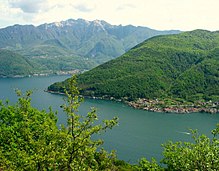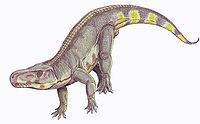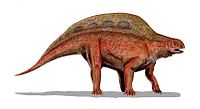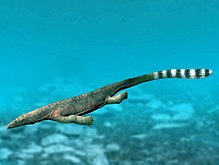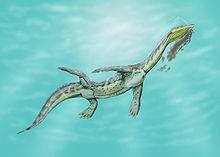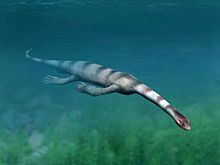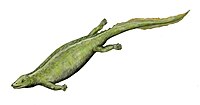From Wikipedia, the free encyclopedia
Monte San Giorgio preserves many exceptionally preserved Ladinian aged vertebrate fossilsThe Ladinian is a stage and age in the Middle Triassic series or epoch . It spans the time between 242 Ma and ~237 Ma (million years ago).[ 8] Anisian and succeeded by the Carnian (part of the Upper or Late Triassic ).[ 9]
The Ladinian is coeval with the Falangian regional stage used in China.
Stratigraphic definitions
The Ladinian was established by Austrian geologist Alexander Bittner in 1892. Its name comes from the Ladin people that live in the Italian Alps (in the Dolomites , then part of Austria-Hungary ).
The base of the Ladinian stage is defined as the place in the stratigraphic record where the ammonite species Eoprotrachyceras curionii Budurovignathus praehungaricus GSSP ) is at an outcrop in the river bed of the Caffaro river at Bagolino , in the province of Brescia , northern Italy .[ 10] Daxatina canadensis
The Ladinian is sometimes subdivided into two subages or substages, the Fassanian (early or lower) and the Longobardian (late or upper). The Ladinian contains four ammonite biozones, which are evenly distributed among the two substages:
Ladinian life
Many Ladinian and Carnian vertebrates have been discovered in the Paleorrota Geopark in Brazil : Rhynchosaurs , thecodonts , exaeretodonts , Staurikosaurus Guaibasaurus Saturnalia tupiniquim Sacisaurus Unaysaurus Santa Maria Formation and the Caturrita Formation .
Vertebrates of Ladinian age include:
Actinopterygians
Coelacanths
Dipnoi
Dipnoi of the Ladinian
Taxa
Presence
Location
Description
Images
Longobardian, Germany
Erfurt Formation
An extinct but derived lungfish.
Archosaurs of the Ladinian
Taxa
Presence
Location
Description
Images
Orenburg Oblast , Russia
A basal predatory archosauriform, a member of Erythrosuchidae .
Chalishevia
Bashkortostan , Russia
An indeterminate archosaur, possibly a rauisuchid .
Lower Santa Maria Formation , Paleorrota Geopark , Brazil.
A member of Aphanosauria , basal relatives of dinosaurs and pterosaurs.
Tongchuan Formation, Shanxi , China
Yonghesuchus was not considered to be a crown-group archosaur, but rather a closely related advanced archosauriform, but in most recent analyses, Yonghesuchus has been recovered as in a well supported clade, the Gracilisuchidae within the Pseudosuchia , along with Gracilisuchus and Turfanosuchus .
All across Europe
Zanclodon is the name formally used for fossil material that might actually belongs to at least two genera of dinosaur from the Late Triassic among other genera.
Suchians
Lepidosauromorphs
Therapsids
References
Notes
^ Widmann, Philipp; Bucher, Hugo; Leu, Marc; et al. (2020). "Dynamics of the Largest Carbon Isotope Excursion During the Early Triassic Biotic Recovery" . Frontiers in Earth Science . 8 (196): 196. Bibcode :2020FrEaS...8..196W . doi :10.3389/feart.2020.00196 ^ McElwain, J. C.; Punyasena, S. W. (2007). "Mass extinction events and the plant fossil record". Trends in Ecology & Evolution . 22 (10): 548–557. doi :10.1016/j.tree.2007.09.003 . PMID 17919771 . ^
Retallack, G. J.; Veevers, J. ; Morante, R. (1996). "Global coal gap between Permian–Triassic extinctions and middle Triassic recovery of peat forming plants" . GSA Bulletin . 108 (2): 195–207. Bibcode :1996GSAB..108..195R . doi :10.1130/0016-7606(1996)108<0195:GCGBPT>2.3.CO;2 . Retrieved 2007-09-29 .
^ Payne, J. L.; Lehrmann, D. J.; Wei, J.; Orchard, M. J.; Schrag, D. P.; Knoll, A. H. (2004). "Large Perturbations of the Carbon Cycle During Recovery from the End-Permian Extinction" . Science . 305 (5683): 506–9. Bibcode :2004Sci...305..506P . doi :10.1126/science.1097023 . PMID 15273391 . S2CID 35498132 . ^ Ogg, James G.; Ogg, Gabi M.; Gradstein, Felix M. (2016). "Triassic". A Concise Geologic Time Scale: 2016 . Elsevier. pp. 133–149. ISBN 978-0-444-63771-0 ^ Brack, Peter; Rieber, Hans; Nicora, Alda; Mundil, Roland (December 2005). "The Global boundary Stratotype Section and Point (GSSP) of the Ladinian Stage (Middle Triassic) at Bagolino (Southern Alps, Northern Italy) and its implications for the Triassic time scale" . Episodes . 28 (4). doi :10.18814/epiiugs/2005/v28i4/001 . Retrieved 23 December 2020 . ^ Mietto, Paolo; Manfrin, Stefano; Preto, Nereo; Rigo, Manuel; Roghi, Guido; Furin, Stefano; Gianolla, Piero; Posenato, Renato; Muttoni, Giovanni; Nicora, Alda; Buratti, Nicoletta; Cirilli, Simonetta; Spötl, Christoph; Ramezani, Jahandar; Bowring, Samuel (September 2012). "The Global Boundary Stratotype Section and Point (GSSP) of the Carnian Stage (Late Triassic) at Prati Di Stuores/Stuores Wiesen Section (Southern Alps, NE Italy)" (PDF) . Episodes . 35 : 414–430. Retrieved 13 December 2020 . ^ http://www.stratigraphy.org/index.php/ics-chart-timescale ^ For a detailed geologic timescale see Gradstein et al. (2004)
^ The GSSP was established by Brack et al. (2005)
Literature
Brack, P.; Rieber, H.; Nicora, A. & Mundil, R. ; 2005 : The Global boundary Stratotype Section and Point (GSSP) of the Ladinian Stage (Middle Triassic) at Bagolino (Southern Alps, Northern Italy) and its implications for the Triassic time scale , Episodes 28(4) , pp. 233–244.Gradstein, F.M.; Ogg, J.G. & Smith, A.G. ; 2004 : A Geologic Time Scale 2004 , Cambridge University Press .
External links
45°49′09″N 10°28′16″E / 45.8193°N 10.4710°E / 45.8193; 10.4710
